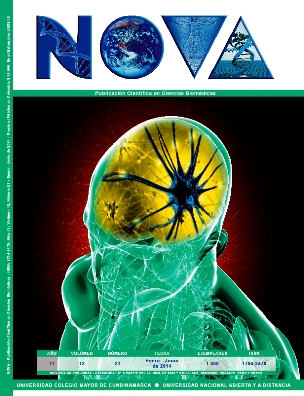Validación de un instrumento para valorar la adherencia de pacientes al tratamiento hipertensivo
Validation of an instrument to assess patient adherenceto antihypertensive therapy

NOVA por http://www.unicolmayor.edu.co/publicaciones/index.php/nova se distribuye bajo una Licencia Creative Commons Atribución-NoComercial-SinDerivar 4.0 Internacional.
Así mismo, los autores mantienen sus derechos de propiedad intelectual sobre los artículos.
Mostrar biografía de los autores
Se validó un instrumento diseñado para medir la adherencia al tratamiento hipertensivo conformado por 10 ítems tipo Escala Likert. Se evaluó la validez de constructo mediante análisis factorial y confiabilidad por medio del Alpha de Cronbach. El análisis factorial permitió agrupar los ítems en torno a los factores que componen dicho constructo. El valor de Alfa obtenido (0,515) corresponde a un valor moderado lo que significa que el instrumento puede ser utilizado como técnica adecuada de recolección de datos.
Visitas del artículo 291 | Visitas PDF 208
Descargas
- Ross, S., Walker, A. y MacLeod, M.J. Patient compliance in hypertension: Role of illness perceptions and treatment beliefs. Journal of Human Hypertension. 2004;18: 607-613.
- Miller, N.H. Compliance with treatment regimens in chronic asymptomatic diseases. American Journal of Medicine. 1997; 102: 43-49.
- Svensson, S., Kjellgren, K.L., Ahlner, J. y Saljo, R. Reason for adherence with antihypertensive medication. International Journal of Cardiology. 2000; 78: 157-163.
- Thrall, G., Lip, G.Y.D. y Lane, D. Compliance with pharmacological therapy in hypertension: Can we do better, and how? Journal of Human Hypertension. 2004; 18: 595-597.
- Wogen, J., Kreilick, C., Livornese, R.G. y Frech, F. A population-base d study of complianceand persistency with cardio-vascular agents used in hypertension management. Journal of Hypertension. 2001; 4: 2-12A.
- August P. Initial treatment of hypertension. N Engl J Med. 2003; 348 (7): 610-617.
- Pescatello LS, Franklin BA, Fagard R, et al. American College of Sports Medicine. Position stand exercise and hypertension. Med Sci Sports Exerc. 2004; 36 (3): 533-553.
- Luciano, M.C. y Herruzo, J. Some relevant components of adherence behavior. Journal of Behavior Therapy and Experimental Psychiatry. 1992; 23: 117-124.
- Brondolo, E., Raymond, C., Rosen, P., John, B. y Kostis, M. Relationship of physical and mood to perceived and ac-tual blood pressure in hypertensive men: A repeated-mesures desing. Psychosomatic Medicine. 1999; 61: 311-318.
- Gil Roales-Nieto, J. Manual de Psicología de la Salud. Comportamiento y Salud/Enfermedad. Granada: Némesis. 2000 (2).
- Leventhal, H., Meyer, D. y Nerenz, D. The commonsense representation of illness danger. En S. Rachman (Ed.), Contributions to medical psychology. Oxford: Pergamon Press.1980; 2: 7-30.
- Visdómine, C. y Luciano. C. Locus de control y autorregulación conductual: revisiones conceptual y experimental. Inter-national Journal of Clinical and Health Psychology. 2006; 6: 729-751.
- Colas, M. y Buendia, L. Investigación Educativa. Sevilla, España: Ediciones Alfar. 1998.
- Canales, M. Metodología de investigación social. Introducción al oficio. Chile: LOM Ediciones. 2006.
- Granados Gámez, G., Gil Roales-Nieto, J. e Ybarra Sagarduy, J.L. Un estudio exploratorio sobre el desarrollo de creencias sobre síntomas como señales de hipertensión arterial. Psicothe-ma. 2006; 18: 822-827.
- Higgins, L.J. The associations of personal body awareness, symptom perception, and time line anticipation with adherence behavior of adults with primary hypertension. Doctoral
- Hernández, R. Fernández, C. y Baptista, P. Metodología de la investigación. Editorial McGraw-Hill. 1996.
- Haynes RB, Ackloo E, Sahota N, McDonald HP, Yao X. Interventions for enhancing medication adherence.
- Ross S, Walker A, MacLeod MJ. Patient compliance in hypertension: Role of illness perceptions and treatment be-lief. J Hum Hypertens. 2004; 18: 607-13. http://dx.doi.org/10.1038/sj.jhh.1001721
- Petrie KJ, Jago LA, Devcich DA. The rol of illness perceptions in patients of medical conditions. Curr Opin Psychiatry. 2007; 20: 163-7. http://dx.doi.org/10.1097/YCO.0b013e328014a871
- Rumbo JM, Arantón L, Goas UR, López N, Rivera P, Campos JM. Legibilidad de la documentación escrita en UCI. Neu-quén: Federación Argentina de Cardiología; 2005. http://www.fac.org.ar/ccvc/llave/tl187/tl187.pdf
- Rodríguez, H., Molero, M. y Acosta, L. Cumplimiento del tratamiento antihipertensivo en un área de salud. 2004. http://www.monografias.com/trabajos15/antihipertension/antihipertension.shtml
- ----------------------------------------------------------------------------
- DOI: http://dx.doi.org/10.22490/24629448.1001





